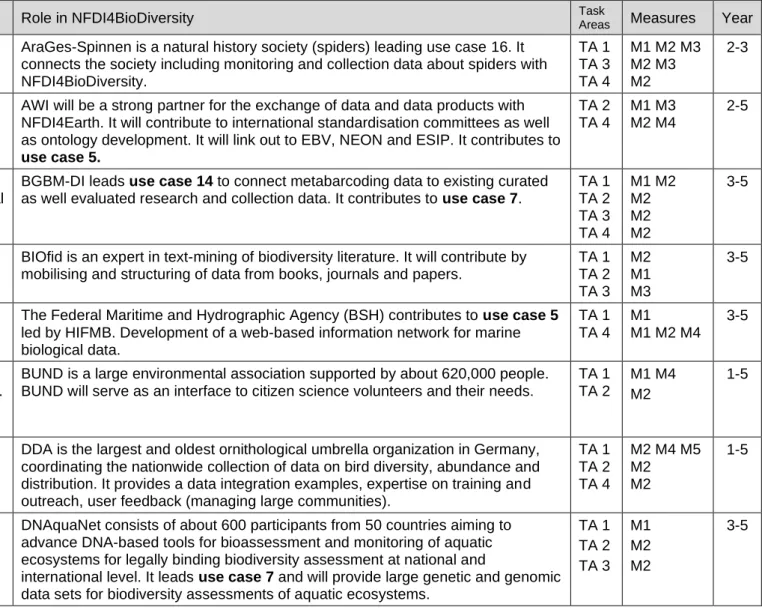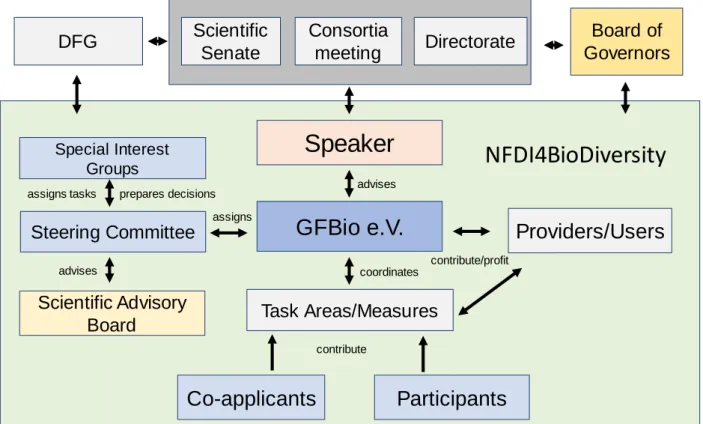Work Area 1 - Community Engagement (2involve): This work area will connect different knowledge holders and take care of research data management requirements related to biodiversity data. Task Area 5 - Coordination, Collaborative Management and Sustainability: This task area implements the NFDI4BioDiversity governance and coordination model.
Research domains or research methods addressed by the consortium, objectives
Data curation by ensuring that data transformations are adequately documented in metadata is therefore key to any data reuse. Certification will be an important measure to gain community trust regarding data storage and reuse.
Composition of the consortium and its embedding in the community of interest
The viability of the consortium will be guaranteed by evaluation and admission procedures as well as EXIT strategies for co-applicants and participants. SUB is one of the largest libraries in Germany, a leader in digital library development and involved in national and international networks and other NFDIs.
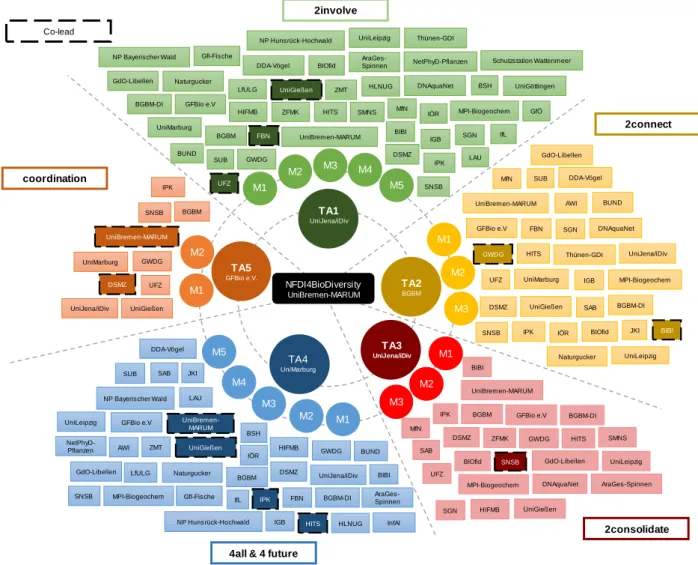
The consortium within the NFDI
We expect that NFDI-wide rules will be drawn up for the evaluation and admission of additional participants as described in detail in section 2.5. This cross-cutting topic will be addressed in task areas 2, 3 and 4. NFDI4BioDiversity plans the implementation of the NFDI Research Data Commons to bring together data and applications to leverage data science for the various stakeholders.
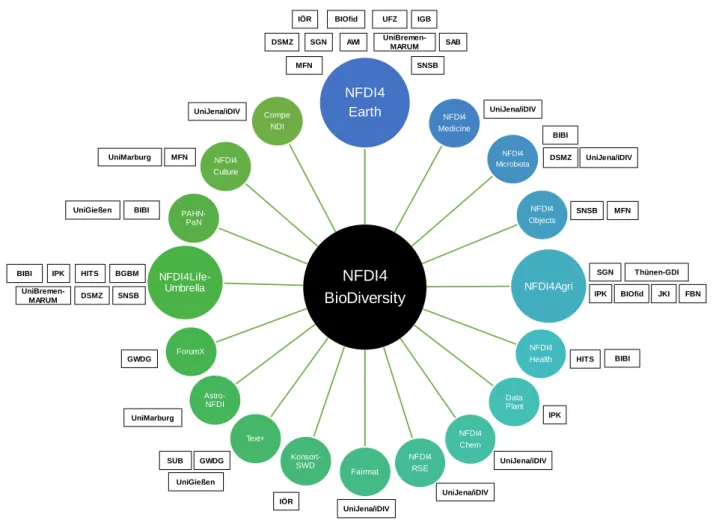
International networking
The Earth Observation Group's Biodiversity Observation Network (GEO BON) [6]: GEO BON has shown stability and structured growth at both regional (e.g. arctic BON) and thematic (e.g. marine BON) dimensions. Furthermore – and related initiatives such as ALTER NET [71] – serve to inform at multiple levels the domain of policies that can be applied in the German national context.
Organisational structure and viability
Financial compensation will be taken from centrally managed funds managed by UniBremen-MARUM. Based on their advice/decisions, the next share of the budget will be distributed to co-applicants and participants via UniBremen-MARUM. It is likely to be a key component in the process of evaluating grants from centrally managed funds (see SIG4).
Together with the chairman, the executive board will be the first point of contact for inquiries from inside and outside the consortium. To professionally fulfill its duties, all critical core services provided by the consortium will be operated by GFBio e.V. In the case of software, it will be assessed whether it can be maintained by GFBio e.V.
In case the consortium is to be dismantled, there is an EXIT strategy (see Task Area 5).
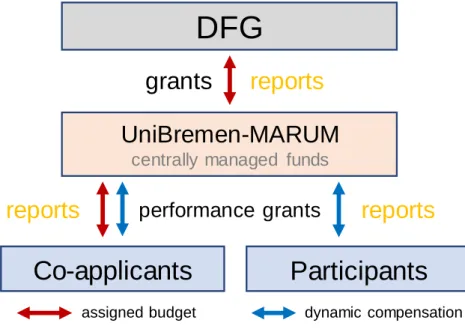
Operating model
Organization of the management of the federated de.NBI cloud and operation of the de.NBI cloud. UniMarburg Development and maintenance of the VAT system, which serves for visualisation, analysis and transformation of biodiversity and environmental data. BIOfid Access to current and historical biodiversity literature, reusable tools for text mining, advanced semantic search technology, ontologies and terminologies.
Special attention will be given to data management support for our use cases (TA1 M1). To reduce the complexity and effort required to develop and maintain the resulting mediation framework, we will push for a limited number of protocols and content standards (cross-cutting topics). Examples are the US National Cancer Institute's RDC [204] and the Australian Research Data Commons [205] with which we will collaborate.
In the establishment phase (2020-25), we will reach consensus and consolidate the services and requirements of our friends and participants as part of the biodiversity community.
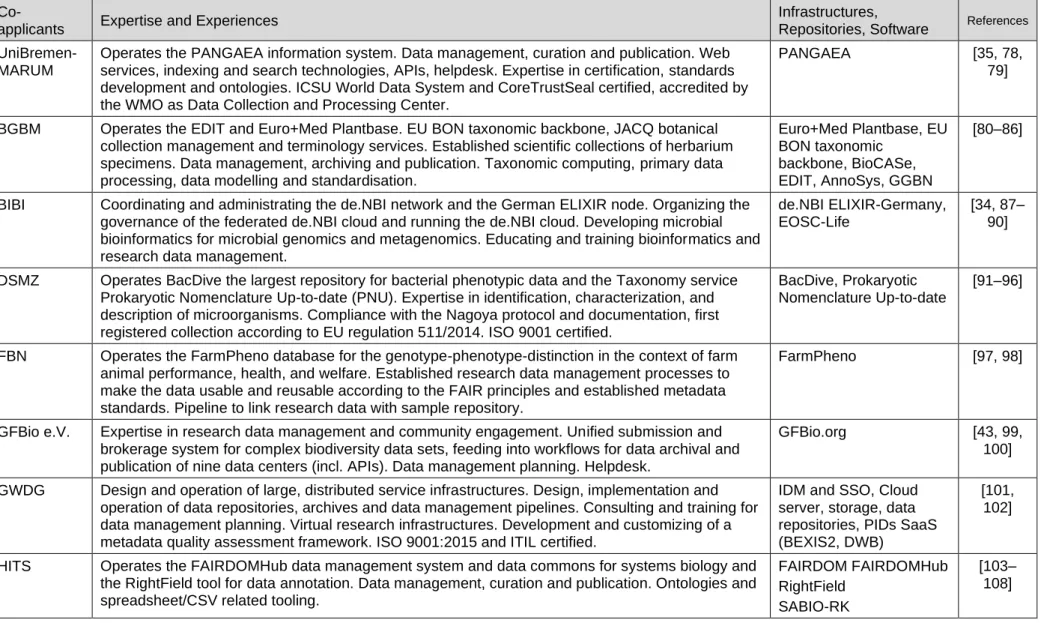
Metadata standards
In addition to supporting specialized community portals, we will expand the current GFBio data portal to include metadata from affiliated NFDI consortia. At the national level, we will work with all NFDI consortia, especially NFDI4Earth and NFDI4Agri, to design and create the NFDI-RDC (Berlin Declaration). Design considerations such as clarity, flexibility and extensibility will be considered when selecting appropriate standards.
Through the NFDI4BioDiversity consortium, we will engage regional biodiversity researchers and service providers to advocate for their needs among developers and federations of semantic interoperability systems. With several "ontology" partners on board, we will leverage existing collaborations with key developers and representatives of global reference ontologies to make rapid and practical progress and prevent the creation of new silos. The Terminology Service, developed as part of the GFBio initiative [62], provides a unified API for cached terminology needed in processes such as data integration, annotation, and query expansion.
An important application will be the services provided by Task Area 4 for the transformation of data schemas whose semantic bases (terminologies, ontologies, relationships between concepts) can be retrieved from the terminology services.
Implementation of the FAIR principles and data quality assurance
This is already part of the GFBio work program and the main objective of the H2020 project FAIRsFAIR [67] (participating NFDI4BioDiversity partners).
Services provided by the consortium
Overview of task areas
Task Area 1: Community engagement (2involve)
Challenge: Connecting and expanding the GBOL infrastructure to the NFDI-RDC so that data can be used in larger contexts. Objectives and Milestones: (1) Evaluation of collected data and associated metadata; (2) Optimization of data visualization; (3) Collaborative interface development; (4) Integration of taxonomic and/or geographical indices in the background; (5) Data mobilization, harmonization, aggregation and quality management; (6) Training of volunteers in the use and expansion of the naturgucker.de portal. Objectives and milestones: (1) Standardization of AraGes data products for interoperability with NFDI-RDC and the German monitoring portal; (2) Implementation of web interfaces and APIs to optimize interoperability a) between the AraGes IT infrastructure, the “ARAMOB ecological database” and the “ATLAS records database”, and NFDI4BioDiversity tools and services;
Challenge: Creating a uniform, comparable and interdisciplinary documentation of national parks research projects, with the aim of making them more accessible to the (specialist) public and ultimately to the NFDI. Among other things, this includes the networking of state authorities in order to establish minimum standards for the collection and documentation of species observation data, thus improving the quality and readability of the data. Description: NFDI4BioDiversity's RDM strategy relies on close collaboration with providers and users of research data throughout all phases of the data lifecycle.
The platform will contain selected datasets and case studies covering different aspects of the data lifecycle closely related to the NFDI4BioDiversity use cases (TA1 M1) and objectives.
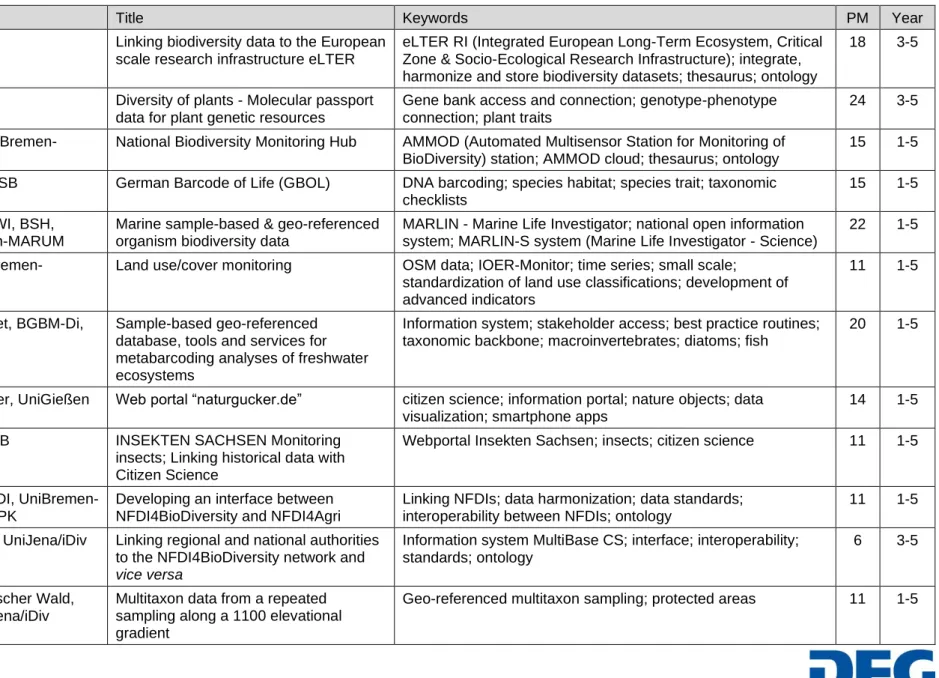
Task Area 2: National and international networking (2connect)
Where appropriate and prudent, we will offer the development, delivery and maintenance of common services to other consortia, ideally as part of the NFDI-RDC. M2.1.4 Requirements for common services across consortia submitted 48 M2.1.5 Implementation of cross-consortia services within NFDI-RDC completed 60 TA2 M2: Context with international services & developments. Availability, performance and robustness of the underlying basic services are essential for the long-term sustainability of this approach.
The relevant basic services will be documented and described in the open registration system (see TA3). M2.2.1 Completed first strategic report on international participation 12 M2.2.2 NFDI4BioDiversity open registration system established and operational and. M2.2.3 Completed 2nd strategic report on international participation 36 M2.2.4 The NFDI4BioDiversity open registration system is fully functional and accessible via.
M2.3.2 Standards landscape analysis published in peer-reviewed journal 24 M2.3.3 Standards assessment and calibration documented on NFDI4BioDiversity.
Task Area 3: Long-term data, tools and service preservation, certification (2consolidate)
TA3 M2: Profiling biodiversity tools, technical services and data centers, adopting them as NFDI-RDC recommended and guiding them towards certification. Professional profiling of tools, technical services and data pipelines will be performed according to the recommended use in the NFDI4BioDiversity and NFDI-RDC context and according to the intended user spectrum (e.g. end user, data scientist or server administrator). This primarily includes work to provide tools, technical services and data pipelines as part of NFDI-RDC.
Such data products are easier to integrate into the NFDI-RDC environment (TA4) and last but not least facilitate the archiving of OAIS [249] in accordance with the reusable data product standards of well-structured and reproducible research results. Schemas and APIs for NFDI-RDC: We will create new types of well-curated highly structured data products. Similarly, APIs of data analysis tools will be developed that allow submission of NFDI4BioDiversity compliant data and their integration into the NFDI-RDC environment (TA4 M1).
Performed first improvement of data pipelines in data repositories towards schema.org and NFDI-RDC compliance; the first optimized highly structured data products for dynamic datasets.
Task Area 4: Data integration, exploration, and exploitation - the NFDI-Research Data
The development and operation of the NFDI-RDC will be coordinated and monitored by the NFDI-RDC coordinator at GFBio e.V. Data will be made accessible in two ways, either by importing external data into NFDI-RDC or by providing data proxies. The data transferred to this interface will be based on the standards developed in TA4 M2 and can be handled using its tools.
Based on pilot applications, required services and APIs will be coordinated and specified. Data access: Access to the data layer will be possible through JSON over REST [259]. The design and engineering of the REST API will be carried out in close collaboration with all biodiversity communities.
Data binding and schema transformation will be based on the tools developed in TA4 M2.
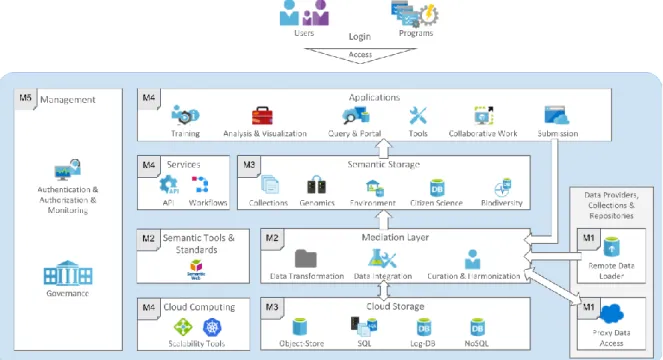
Task Area 5: Coordination, Collaborative governance & sustainability
For the sake of comparability, data will be managed as time series in dedicated systems such as InfluxDB [258]. He/she will be part of the SC, where he/she is involved in decision-making and closely interact with GFBio e.V. He/she will be responsible for overseeing the overall development of the NFDI-RDC platform in TA4.
Under the leadership of SIG2, he will participate in the certification of archival material and quality control and assurance. A gap analysis will then be carried out using the results of the cost analysis against the available financial base, which for the establishment phase of NFDI4BioDiversity will be based on NFDI/DFG funding and in-kind contributions from project partners. The final result will be a common business model that will determine the financial rules for the operation of the infrastructure and the way in which financial resources are allocated for each contributing component.
If a solution cannot be found, it will be escalated to the NFDI Management and Scientific Senate.
Bibliography and list of references
